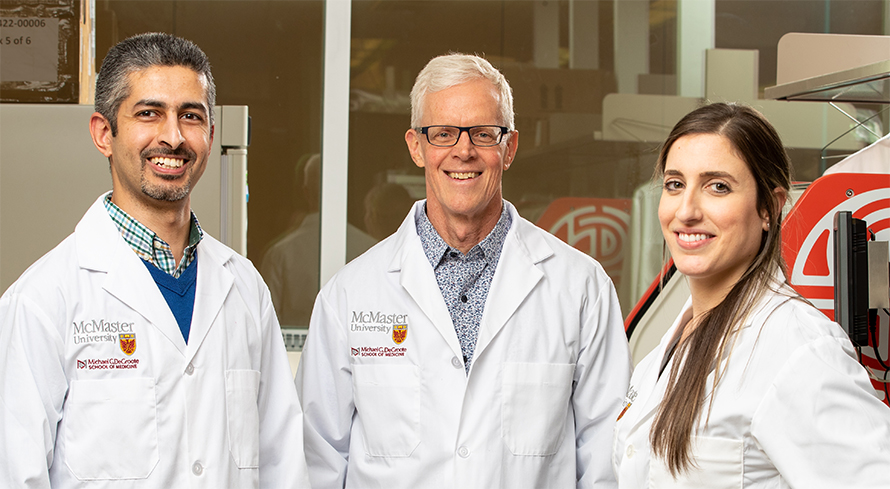Cannabis: A secret weapon against superbugs
Although the novel coronavirus has grabbed most headlines in recent months, antimicrobial resistance remains a critical challenges for public health agencies around the world, notably the rapid spread of methicillin-resistant Staphylococcus aureus, known as MRSA. In the fight against this superbug, Eric Brown employs an unconventional research approach, developing novel drug molecules from natural products, specifically from Cannabis sativa.
“Natural products have the potential to solve the issue of drug resistance in pathogenic bacteria,” Brown said. “This is a great resource that we haven’t fully investigated. Researchers in academia have the tools and ability to pursue outlandish ideas, which can be steered to the development of new therapeutic agents.”
As the Canada research chair in microbial chemical biology and a professor of biochemistry and biomedical sciences at McMaster University, Brown leads an interdisciplinary research team that has detected a cannabinoid called cannabigerol or CBG.
“Cannabis plants are known to produce compounds to block the invading pathogens,” Brown said. “We decided to take benefit of the regulatory environment in Canada and use Cannabis to tackle the emerging threat of drug resistance.”
Since the 2018 legalization of marijuana in Canada, Brown’s lab has been studying the antibiotic potential of cannabis. This research has some stigma associated with it, Brown said, but there is circumstantial evidence for medicinal use of the plant. The team established the antibacterial properties of CBG and found that it was highly effective at controlling MRSA in mice. Controlling MRSA is challenging as it is resistant to all known beta-lactam antibiotics. Further, the lab’s study published in the journal American Chemical Society Infectious Diseases found that CBG targeted the cell membrane of bacteria and prevented formation of biofilms, bacterial communities that adhere to each other and surfaces, and also destroyed existing biofilms.

The team also demonstrated the potential of CBG in combination with antibiotic therapy to combat increasing instances of drug resistance in bacteria. CBG with polymyxin B inhibited the growth of Gram-negative pathogens that are resistant to multiple drugs, such as Acinetobacter baumannii, Escherichia coli, Klebsiella pneumonia and Pseudomonas aeruginosa, revealing the broad-spectrum therapeutic potential for cannabinoids. But the compound is not without drawbacks.
“CBG is great at attacking pathogenic bacteria; however, it is toxic to host cells,” Brown said. “Further research and development are needed to ultimately have a safe drug for therapeutic purposes.”
Although the lab has developed creative chemical-biology approaches to characterize novel antimicrobial compounds from natural products, they face additional challenges. “A major hurdle in natural product drug discovery is the chemical synthesis of these molecules,” Brown said.
For this, they collaborated with Jakob Magolan, a McMaster associate professor of biochemistry and biomedical sciences whose research focuses on using organic synthetic chemistry in drug development. “When you take an unusual research project,” Brown said, “it is great to have a team with complementary expertise, as it helps to advance the field (by) rapidly overcoming hurdles.”
Brown hopes to pursue the commercialization of CBG in collaboration with partners in the pharma industry.
Enjoy reading ASBMB Today?
Become a member to receive the print edition four times a year and the digital edition monthly.
Learn moreGet the latest from ASBMB Today
Enter your email address, and we’ll send you a weekly email with recent articles, interviews and more.
Latest in Science
Science highlights or most popular articles

Bacteriophage protein could make queso fresco safer
Researchers characterized the structure and function of PlyP100, a bacteriophage protein that shows promise as a food-safe antimicrobial for preventing Listeria monocytogenes growth in fresh cheeses.

Building the blueprint to block HIV
Wesley Sundquist will present his work on the HIV capsid and revolutionary drug, Lenacapavir, at the ASBMB Annual Meeting, March 7–10, in Maryland.

Gut microbes hijack cancer pathway in high-fat diets
Researchers at the Feinstein Institutes for Medical Research found that a high-fat diet increases ammonia-producing bacteria in the gut microbiome of mice, which in turn disrupts TGF-β signaling and promotes colorectal cancer.

Mapping fentanyl’s cellular footprint
Using a new imaging method, researchers at State University of New York at Buffalo traced fentanyl’s effects inside brain immune cells, revealing how the drug alters lipid droplets, pointing to new paths for addiction diagnostics.

Designing life’s building blocks with AI
Tanja Kortemme, a professor at the University of California, San Francisco, will discuss her research using computational biology to engineer proteins at the 2026 ASBMB Annual Meeting.

Cholesterol as a novel biomarker for Fragile X syndrome
Researchers in Quebec identified lower levels of a brain cholesterol metabolite, 24-hydroxycholesterol, in patients with fragile X syndrome, a finding that could provide a simple blood-based biomarker for understanding and managing the condition.

